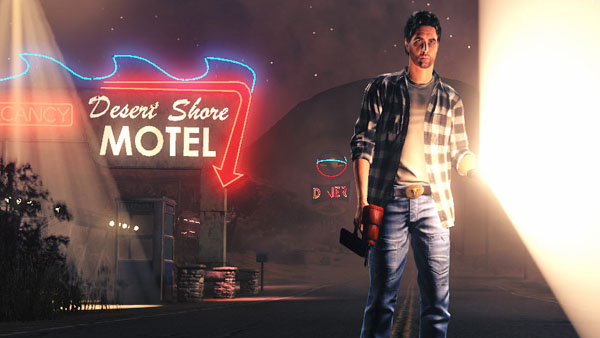Remedy first showed Alan Wake at Microsoft’s X06 which seems such a long time ago now, originally planned as one of the early exclusives for the Xbox 360 when it launched, the game went through some changes before becoming the reality that it is today. Touted as being a free roaming action thriller, the game looked very good, and at the time showcased some rather impressive dynamic lighting and physics effects, certainly impressive looking back in 2006, and if you look at the screenshots that were released around that time, the vast landscapes of Bright Falls with its mountainous woodland areas became the embodiment of expectation. Well that was four years ago, and it seemed Remedy weren’t so keen on the direction the game was taking and so decided to take a step back and offer a less open, more rigid experience that focused on the storyline as much as the gameplay. A lot was mentioned about an episodic approach, and taking inspiration from TV series’ such as 24, Lost etc. the game grew into the experience it is today.
Staring, Alan Wake, a writer on a mission, heading off to the relaxing climes of Bright Falls, to get away from it all with his wife, turns into a living nightmare as the realms of reality and fantasy blur and his world is turned upside down to create an engaging adventure for the inquisitive gamer. Not pulling any punches with a flashy title, the game, as it was back then is simply Alan Wake, and this is his story in more ways than one.
Gameplay:
At its heart Alan Wake (hereby referred to as just AW to avoid confusion with the name of the main protagonist) is a third person survival horror game, much in the vein of Silent Hill, and the old school Resident Evil games, although what really separates this from its peers is a lack of taxing cerebral moments. There’s some element of having to find the odd key to progress, but never in situations that are totally surreal and absent from reality. This creates a more realistic game despite the fact that throughout the story, Alan Wake fights with fact and fiction to progress the narrative. A key might be in the most obvious place, on a desk somewhere, never hidden away behind a puzzle which would slow the pacing down as you tried to work out what’s what. This actually works well in context of the game as you’re experiencing what Alan is on a more visceral level taking away the sublime and replacing it with the game’s combative and exploration elements.
The exploration is fairly linear as your pathway is highlighted with the use of an on-screen radar which shows you where to go for the next objective, but this isn’t too imposing as looking around in the dark remains tense and totally engaging due to some excellently crafted locales and the fact that you’re never too far away from something going bump in the night. The open nature of some of the locales means there’s always some distraction to look into for those of you not glued to the on-screen radar. Delving away from the scripted path can lead to more interesting revelations, and for those wanting a fuller experience, it’s recommended that you do take in your surroundings. On occasion you’ll be able to drive vehicles, which seems to hark back to the days when the game was a free roaming adventure. Their inclusion whilst welcome does feel a little tacked on and in comparison to the rest of the game aren’t as well realised, especially with such a horrid camera which snaps back to neutral rather than giving the gamer full control.
The combat is actually a huge part of the game, second in command to the navigation from A to B. The handy opening episode, shows you all you need to know in the one go, and from then on in it’s a case of developing the skills and using what’s given to you as a true survivalist. Light is your friend in this game whether it be a well illuminated piece of ground under a bright light which quickly replenishes health, to the frequent use of a flashlight to weaken foes, banishing the darkness from them, before letting rip with one of the many conventional weapons available. Unlike other third person action games, there’s no cross-hairs on screen and the only way to aim successfully is to bring up the flashlight with the Left Trigger and hold it over an enemy, this also doubles up as a booster of the light source which weakens enemies much quicker than merely pointing the light at them. What happens is a circle will appear over the enemy who is illuminated by the light, which gradually decreases in size the longer you hold it over the enemy (although enemies will move about and attack with axes, chainsaws and such like, so some skill is required). By holding the LT you’ll use up batteries which if the charge reaches zero then the light begins to flicker and loses it’s effectiveness until you hit the Y button to effectively reload batteries. It’s a bit silly, but in this game the flashlight is an equal weapon along side the conventional shotguns, hunting rifle and pistol. There’s more to the light based weapons alongside flashlights which get stronger as you progress through the episodes, in the form of a flare gun, flashbang grenades and flares which are most useful against swarms of enemies and those which are a bit tougher to deal with. The flashbangs for example are great for killing more than one enemy at time and the flares push back any would be attackers giving you some momentary breathing space to reload or prepare your next move.
AW is filled with gritty realism amongst the paranormal and so poses a slight problem in terms of the enemies you’ll encounter. There are no monsters or zombies, instead the game favors real humans, possessed by the darkness (called Taken). There’s little variation other than you’ll see variants in their sizes and attack patterns. The massive hulking guys taking more light to dispel the darkness from them before you can finish them off with a few shots from a normal weapon. After the full six episodes it can get a bit tiring, although much like zombies in other games, the way they appear and re-appear constantly keeps you on your toes.
It’s not all doom and gloom though because alongside the human foes, there are plenty of birds to kill (taking influence from the old Hitchcock movie no doubt). The game also adds an unseen force to reckon with, introducing the poltergeists about half way through the game. These forces of evil possess a number of inanimate objects (some quite large such as bulldozers) which hurl themselves at poor Mr Wake. However, with trusty flashlight in hand, Alan is able to dispossess them much in the same way as the regular enemies. Their appearance is welcome and ups the anti somewhat.
Aside from the combat which really does come thick and fast from start to finish, the game boasts an engaging story that will keep you glued to the TV set – it’s not the most complex of tales, but by video game standards is fulfilling and gripping enough to remain constant and entertaining without becoming stale. The game switches to cut scenes to emphasise various points in the plot, and the characters you meet are as far out as the rest of the game’s premise. The presentation is very much like a TV show and with the six episodes you’ll get a recap of what’s happened at the start of a new one as the endings each rests on a cliffhanger type moment.
Graphics:
Bright Falls is the perfect idyllic location, set within expansive woodland areas, calm lakes and jagged peaks. The ideal location for a writer to get away from the hustle and bustle of the big city and let the mind wander. The game presents this locale with style and finesse, with the contrast between Bright Falls daytime, and Bright Falls at night; the former being calm and tranquil often displaying fine sunsets amidst dusky skies whereas the latter opens up an entirely new can of worms. At night the peace stops and the madness begins as your view in shrouded in shadows and movement. Not content with simply dimming the light sources, the inclusion of eerie mist and raging winds create panic and uncertainty. As you would expect, there’s a lot of foliage which shifts in the calm winds one moment, and heaves in the raging gales the next. The trees in particular are very impressive as they move with an uncanny realism. You can almost smell the waxy odour of the evergreen trees as they beckon you to enter their domain.
You might have guessed already, but there are a lot of trees, to the extent the locales are quite similar in appearance, and often than not you might feel a slight twinge of deja vu from time to time. Events are kept interesting by use of buildings (deserted or otherwise) and the constant threat of enemy attacks. Alan’s flashlight illuminates a small area, and so you do spend a lot of time pointing the light to get a fix on what’s around you trees or otherwise. The creation of dancing shadows is excellent as the atmosphere is second to none this generation of games in the genre.
The character models are good, although Alan can pull some slightly weird facial animations at times. During the cutscenes there’s a warm feeling created towards the characters as the presentation is good enough to keep things watch-able without being too wooden or cringe worthy. Even when there’s some teasing banter between Alan and his wife.
Sound:
The audio is also of a high standard with some chilling sound effects and ambience to suit the mood of the scenes. The music isn’t obtrusive and often gives way to the sounds of what’s around you instead which is a great touch. When the music does kick in at the right moments it is typically horror in its tones and adds more pressure to proceedings. The voice acting is good, with decent performances from Alan and the main cast of characters – Barry in particular sounding more Joe Pesci and offering some light comedy relief from all the seriousness . The inclusion of radio and TV stations to tune into is impressive, with some interesting themes brought in to the game if you’re patient enough to stick around and watch them. It seems someone at Remedy is a fan of the Twilight Zone.
Longevity:
This is a mixed bag and dependant on how thorough you are going to play. On one hand you could simply follow the objective marker and experience the game this way only, missing out on the intricacies of what else is on offer. On the other hand you could strive to search every nook and cranny and look for hidden items and manuscripts which give greater insight into Alan and what’s happening around him. There’s quite a difference in time playing the two different ways, but either way, there’s enough meat on offer to make the adventure worthwhile, and certainly worth replaying again on the unlocked Hard and Nightmare settings. AW is also going to boast some additions to the package via downloadable content at some stage, so even if you’ve exhausted the story, there’s going to be more stuff to keep you hooked in the future. This might of course change your decision as to rent or buy possibly.
Overall:
Remedy has done a cracking job with Alan Wake, providing a game that’s solid entertainment of the survival horror nature from start to finish. There are some moments where the game does feel a bit ‘samey’ in terms of design, but with such an engaging and captivating story, you’ll feel compelled to drive onwards and see it through to its conclusion. The gameplay is well realised, and you’ll rarely feel disconnected from Alan as you trundle through the darkness, flashlight in hand and a bucket load of ammo hidden away in those pockets of his. For gamers feeling somewhat let down by the survival horror offerings of this current generation, should have their faith restored by Alan Wake, as the game delivers an exhilarating ride through six well thought out chapters which take you from the highs of tranquil inner peace, to the depths of despair and confusion. It’s a great game and one that should be played by all gamers who call themselves fans of survival horror. For those of you who are more inclined towards action, might find the pacing a little slow, but enter the game with an open mind and you’ll come out the other side all the better for it.
9/10




